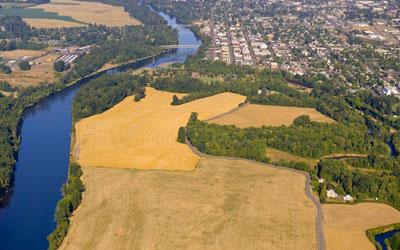EPA Science Matters Newsletter: Ecosystems U - Building a Better Understanding of How Ecosystems Benefit Society (Published January 2014)
EPA researchers are leading efforts to identify and quantify "ecosystem services."
When it comes to the benefits that individuals and communities derive from natural ecosystems—things such as the flood and erosion control that mangrove forests and other wetlands provide, recreational opportunities from parks and water bodies, and the cycling and absorption of excess nitrogen, carbon, and other pollutants—the marketplace often does not capture and reflect true value.
As a result, environmental managers, community planners, and other decision makers who are trying to develop strategies to protect the environment and maintain the long-term health of their communities lack a full accounting of environmental costs and benefits to inform their decisions.
EPA researchers are working to change that scenario by studying and finding ways to quantify the benefits people derive from natural ecosystems, what they refer to as “ecosystem services.” Examples follow.
Tampa Bay Demonstration Project
 Tampa Bay, Florida
Tampa Bay, FloridaTampa Bay, home of Florida’s largest open water estuary and a large and growing urban center, is the focus of the Tampa Bay Demonstration Project, a study to identify and assess the ecosystem services that the Tampa Bay estuary and other local ecosystems provide on a broad scale.
As part of the overall project, researchers recently completed a two-year study of nine mangrove wetlands and 18 freshwater river and marsh sites, each with differing levels of human disturbance. They will use the study results to build a dynamic model that illuminates how disturbances to wetlands affect their ability to perform important ecosystem services, such as absorbing excess nutrients and improving water quality across the Tampa Bay watershed.
“Our science will help stakeholders balance the costs of human-caused stresses to the landscape while sustaining valuable ecosystem services,” explained EPA scientist Marc Russell, Ph.D. “Conducting this kind of research gives us the opportunity to address return-on-investment type of questions about the environment,” adds Janet Nestlerode, Ph.D., also with EPA.
Russell and Nestlerode are helping lead a broad coalition of research and planning organizations, citizens and business groups, and other stakeholders to guide the design of the comprehensive study so that they can all benefit from the research results.
Learn more about the Tampa Bay demonstration project.
Pacific Northwest Demonstration Project
 Willamette River Valley, Oregon
Willamette River Valley, OregonAnother EPA ecosystem services research project is unfolding some 3,000 miles away from Tampa Bay in select inland and coastal communities of the Pacific Northwest, primarily Oregon.
“The goal of the Pacific Northwest Demonstration Project is to develop nationally-applicable models and decision support tools that will quantify the production and value of ecosystem goods and services. We can then share these models and tools with communities to help them become sustainable, that is, to meet their current needs without compromising the future,” explains EPA’s Robert McKane, Ph.D., who is leading the study.
The Pacific Northwest, with its diverse and highly valued natural resources—including forests that are among the most productive on the planet, world-class wineries and other agriculture, and abundant fresh and marine water that support salmon, shellfish, and other fisheries—is an ideal region for such an exploration.
To consider such diversity in the study, the research team is engaging individuals and groups representing a breadth of community groups, decision makers, and other stakeholders in the region in designing the research. That effort will help ensure that the end products (models and tools) will help local communities better understand the long-term consequences that their decisions may have on ecosystem services and community health and well-being.
“By engaging different stakeholders across the region, we are addressing questions about community stability, hopefully helping to advance sustainability practices that end the cycle of boom and bust that the region has experienced historically. Lack of that ability has led to the disruption of once thriving industries such as forest products and salmon fisheries, and has been particularly hard on rural communities,” says McKane.
Mapping California EcoRegions
A team of EPA scientists, together with partners from state, federal, and private organizations, is developing a detailed map identifying California “EcoRegions,” areas defined by the type, quality, and quantity of their environmental resources.
With funding from EPA’s Regional Applied Research Effort (RARE), the scientists analyzed spatial patterns of geology, physiology, vegetation, climate, soils, land use, wildlife, and hydrology across California to identify 177 ecoregions.
“We use ecoregions to systematically categorize geographically distinct assemblages of natural communities and species. Refined ecoregion maps are critical because they provide an effective tool to evaluate and predict ecosystem response to disturbance, both natural and human-related,” explains EPA’s Dr. Cindy Lin, Ph.D., an environmental scientist who serves as the science liaison for the Agency’s Southwest Regional Water Office.
EPA ecosystem services research in places such as Tampa Bay, the Pacific Northwest, California, and elsewhere is part of the Agency’s Sustainable and Healthy Communities Research Program. The program is bringing together diverse teams of researchers to work collaboratively across traditional fields of study to provide the data, models, and tools that communities and decision makers need to protect public health and community stability over the long haul.
